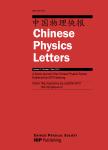Two-Body Hadronic Weak Decays of Bottomed Hadrons
作者机构:Key Laboratory of Atomic and Subatomic Structure and Quantum Control(MOE)Guangdong Basic Research Center of Excellence for Structure and Fundamental Interactions of MatterInstitute of Quantum MatterSouth China Normal UniversityGuangzhou 510006China Guangdong-Hong Kong Joint Laboratory of Quantum MatterGuangdong Provincial Key Laboratory of Nuclear ScienceSouthern Nuclear Science Computing CenterSouth China Normal UniversityGuangzhou 510006China School of Mathematics and PhysicsChangzhou UniversityChangzhou 213164China Southern Center for Nuclear-Science Theory(SCNT)Institute of Modern PhysicsChinese Academy of SciencesHuizhou 516000China
出 版 物:《Chinese Physics Letters》 (中国物理快报(英文版))
年 卷 期:2024年第41卷第2期
页 面:26-35页
核心收录:
学科分类:07[理学] 070203[理学-原子与分子物理] 070202[理学-粒子物理与原子核物理] 0702[理学-物理学]
基 金:partly supported by the National Natural Science Foundation of China (Grant Nos. 12375073, 12035007, 12205106, and 12105028) Guangdong Provincial Fund (Grant No. 2019QN01X172) Guangdong Major Project of Basic and Applied Basic Research (Grant No. 2020B0301030008) the NSFC and the Deutsche Forschungsgemeinschaft (DFG, German Research Foundation) through the funds provided to the Sino-German Collaborative Research Center TRR110 “Symmetries and the Emergence of Structure in QCD” (NSFC Grant No. 12070131001, DFG Project-ID 196253076-TRR 110) supported by the Natural Science Foundation of Jiangsu Province (Grant No. BK20200980)
主 题:transition structure quark
摘 要:The structure of light diquarks plays a crucial role in formation of exotic hadrons beyond the conventional quark model, especially with regard to the line shapes of bottomed hadron decays. We study the two-body hadronic weak decays of bottomed baryons and bottomed mesons to probe the light diquark structure and to pin down the quark–quark correlations in the diquark picture. It is found that the light diquark does not favor a compact structure. For instance, the isoscalar diquark [ud] in Λ_(b)^(0) can be easily split and rearranged to form ■via the color-suppressed transition. This provides a hint that the hidden charm pentaquark states produced in Λ_(b)^(0) decays could be the ■chadronic molecular candidates. This quantitative study resolves the apparent conflicts between the production mechanism and the molecular nature of these P_(c) states observed in experiment.



